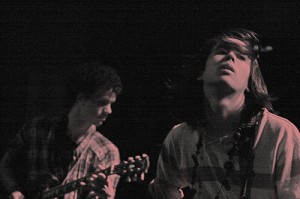
Being young is a good thing. For Chicago pop group Smith Westerns, such a simple adage seems to encompass both their collective spirit and musical tendencies accurately enough.
The Smith Westerns consists of brothers Cullen and Cameron Omori; Cullen is on lead vocals and guitar, Cameron on the bass. Max Kakacek plays the lead guitar, and their drummer is Colby Hewitt. They started playing music when they were in high school.
In spite of their youth (none of them yet exceeding the age of 21), the members of Smith Westerns esteem influences that might have you think twice about their own naïveté.
Their recent album, Dye it Blonde, draws from a host of ‘60s and ‘70s era glam rock and pop more timely for their parents. Twists of Bowie, T. Rex and the Beatles seamlessly lace in and out of all 10 quick tracks.
Evidence of grown-up sensibilities is also at work in the album’s production. Since their self-titled release album, the Smith Westerns have been fortified with a label-supported budget and recording studio, giving them maturity, clarity and sophistication. Where there were once gritty punk songs heard from a basement on their self-titled album, Dye it Blonde employs a slicker, polished aesthetic layered with organ and piano instead of guitar feedback.
Rest assured, the sophisticated vibe does little to compromise the Smith Westerns lo-fi edge or leave them sounding boring. The feeling of youth is still inescapable in just about every other nook of Dye it Blonde.Just listen to “Dance Away” and you’ll hear reckless abandon suitable for a high school dance.
Lead-man Cullen Omori gets flirtatious, singing “Upside down, you turn me on / It’s like fire to the flame / and we’ll dance the night away,” as the tempo transitions from peppy staccato into a flourishing disco groove. Cullen displays a dynamic range of emotional guidance, pushing the mood from angsty to joyful, unsure to confident, innocent to mischievous then back again within a few measures of the same song.
The persuasive moves being made, despite their unpredictability, never come off sounding fickle. Cullendemonstrates a talent to bind his moods creatively and effectively without distancing his listeners too far from any conceptual thread. Before we know it the song ends, and we’re curious to know what directions the next track might take us.
The giddier moments such as “Dance Away” are often followed by drops to moderate, slow-dance sway, as is the case with “Dye the World.” Here the chunky opening guitar riff, at first oddly reminiscent of “Take My Breath Away” from ‘80s blockbuster Top Gun. The song trudges along before howling and bending into higher registers—Cullen following suit, giving us a gutsy show in dreamy, teenage balladry; crooning lines like, “Are you a dream? / Or something in between?”
“All Die Young” starts off with much the same cadence, heavy backbeat and cascading guitar affecting us to a similar dreariness. Slowly the song builds and leads into the chorus where shades of John Lennon’s solo work come alive in stunning energy and pace. Lyrically, Cullen is at his best here: coming close to Lennon’s epic calls to bravery and consoling the throes of love simultaneously. “Imagine Pt. 3,” driven by hard struck piano chords, feels a lot like Lennon’s “Instant Karma.” Not too bad for kids born in the ‘90s.
While it may be true that Smith Westerns have all the courage to explore the sounds of the past—not to mention the charm to craft tender, innocent love ballads—they also have the power to rock out. Where Cullen tends toward clever understatements to give Dye It Blond its charm, guitarist Kakacek provides the fireworks. This is especially noticeable on the rip-roaring “End of the Night” where he lashes through a grimy lick with the strength to clear ground and outline a perfect contour for Cullen’s lighter intonations.
This interplay between vocal and guitar acrobatics is probably the most satisfying feature of Dye It Blonde; moments where they intertwine with one another lay the foundation for the album’s best work.
For example, the single “Weekend,” which happens to be the opening track on Dye It Blonde, is hard to live up to. That’s perhaps the album’s biggest downfall. Though “Weekend” is a perfect opener, a red-hot and engaging one, no other song will be remembered quite like it. The buzzing guitar riff—perhaps owing more to T. Rex this time around—quickly finds its way into your head and stays. From there, Cullen creeps onto the track with hushed verses and a chorus that you can’t help but howl along to. Having the right dosage of youthful vigor and cunning songwriting come at you in full force right from the outset, you may find yourself disappointed not to find more songs like “Weekend” on the rest of Dye It Blonde. But if you’re young, like Smith Westerns, there’s simply no time to look back. It’s OK to make mistakes. After all, you have your whole life ahead of you.
I would give this album three and a half stars out of five.
Smith Westerns have cleaned up nicely. Just over a year ago, the Chicago foursome were of the strictly “lo-fi” persuasion, stirring up hot, filthy garage-rock candy out of Marc Bolan and Beatles signifiers. It was youthful music in feeling and sound– their noisy full-length debut was recorded while they were still in high school– but the remarkable hooks buried therein were clear enough to land them on the increasingly stacked Fat Possum roster. And suddenly, they had a studio budget the likes of which they definitely hadn’t enjoyed before. Though the leap is audibly huge, Dye It Blonde’s many successes aren’t wholly the result of its gilded production values and ambition. This band was able to furnish first-class melodies from the beginning. Now they’ve grown along with their resources.
Wade Underwood.
Yes,I agree with you
This is a superb share. Many thanks for this article.